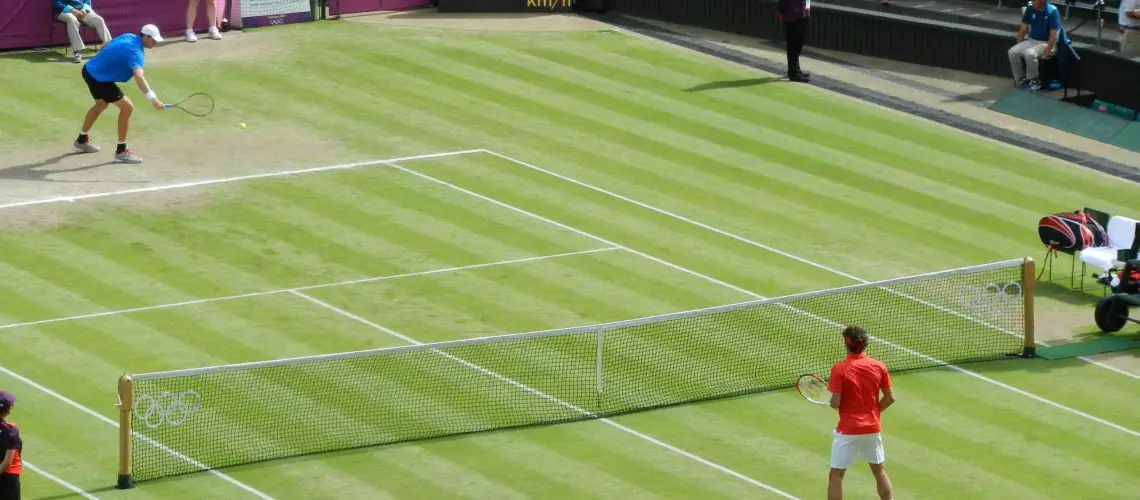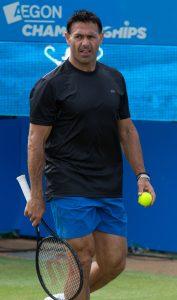We may earn money or products from the companies mentioned in this post.
Brief History of Tennis Racquets

Tennis racquets have come a long way since their humble beginnings Back in the day, players used wooden racquets that were heavy and had a small sweet spot
Evolution from Wooden to Modern Racquets
As technology advanced, so did tennis racquets The introduction of metal frames in the 1960s revolutionized the sport These racquets were lighter and provided more power and control
Fast forward to today, and we have modern tennis racquets made from advanced materials like graphite and carbon fiber These materials offer exceptional strength while keeping the racquet lightweight
Importance of Selecting the Right Racquet
Selecting the right tennis racquet is crucial for any player, whether you’re a beginner or an experienced pro Each player has unique preferences and playing styles that can greatly impact their performance on the court
The weight, balance, head size, string pattern, and grip size are all factors that should be considered when choosing a tennis racquet Finding the perfect combination will help optimize your game and prevent potential injuries
Purpose of This Guide

The purpose of this guide is to provide you with valuable insights into selecting the right tennis racquet for your needs We’ll delve into different aspects such as weight distribution, string tension, and grip style to help you make an informed decision
Choosing the right tennis racquet is not just about enhancing your skills; it’s also about enjoying the game to its fullest potential So let’s dive in and discover how you can find your perfect match on the court!
Factors to consider when choosing a tennis racquet

Choosing the right tennis racquet can greatly impact your performance on the court With so many options available, it’s important to consider several factors before making a decision Let’s explore some key factors that should influence your choice
Player’s skill level and experience
Your skill level and experience in tennis play a crucial role in determining the type of racquet that suits you best Beginner, intermediate, and advanced players have different needs and requirements
-
Differences between beginner, intermediate, and advanced level racquets:
Each level of player requires different features from their racquet Beginner racquets typically offer larger sweet spots for greater forgiveness, while intermediate racquets strike a balance between power and control Advanced-level racquets are designed for experienced players who prioritize control over power -
Understanding your own skill level and goals in tennis:
It’s important to assess your own skills and goals before selecting a racquet Consider whether you’re looking to improve your technique or enhance specific aspects of your game such as power or control
Racquet specifications and how they affect performance
The specifications of a tennis racquet can greatly impact its performance on the court Understanding these specifications will help you make an informed decision
-
Weight distribution: head heavy vs head light vs even balance:
The weight distribution of a racquet affects its maneuverability, power, and control -
a) Power vs control trade-off:
Head-heavy racquets provide more power but may sacrifice some control, while head-light racquets offer greater control at the expense of power Evenly balanced racquets strike a balance between the two -
b) Arm fatigue and maneuverability:
Consider your own physical capabilities and playing style when choosing weight distribution Head-heavy racquets may cause more arm fatigue, while head-light racquets are generally easier to maneuver -
Frame stiffness: flexible vs stiff frames:
The stiffness of a racquet’s frame impacts its power, control, and comfort -
a) Impact on power, control, and comfort:
Stiffer frames provide more power but can be less forgiving on off-center hits Flexible frames offer better control and comfort but may sacrifice some power -
b) Suitability for different playing styles:
Consider your playing style when choosing frame stiffness Aggressive baseline players may benefit from stiffer frames for added power, while all-court players might prefer more flexibility for improved touch and feel -
Size of the hitting surface (head size):
The size of a racquet’s hitting surface, typically measured by head size in square inches, affects several aspects of play -
a) Sweet spot size:
A larger head size results in a larger sweet spot, offering more forgiveness on off-center hits Smaller head sizes provide greater control but require more precision in shot placement -
b) Power vs control trade-off:
Larger head sizes generally generate more power due to their larger string bed area, while smaller head sizes offer enhanced control at the expense of some power
Taking into account these factors will help you make an informed decision when selecting a tennis racquet that aligns with your skill level, playing style, and goals Remember, choosing the right racquet can enhance your performance and enjoyment on the court
When it comes to personalizing your tennis racquet selection process, considering the physical attributes of the player is crucial Age plays a significant role in determining the right racquet Junior players have different needs than adult players, as their bodies are still developing and require different specifications
Height and body strength also come into play when selecting a tennis racquet Finding an appropriate grip size is essential for comfortable and efficient gameplay A grip that is too small or too large can adversely affect your performance on the court, so it’s important to find the right fit
Additionally, previous injuries or physical limitations should be taken into account when choosing a tennis racquet It’s vital to avoid further strain on specific areas of the body that may be prone to injury By selecting a racquet that accommodates these limitations, you can optimize your gameplay while minimizing the risk of exacerbating any existing issues
While there are various factors to consider in finding the perfect tennis racquet, a trial-and-error approach can be highly effective Take advantage of demo programs at local clubs or stores, where you can test out different racquets before making a purchase This allows you to get a feel for how each one performs and determine which suits your playing style best
Another option is borrowing friends’ or teammates’ racquets This gives you an opportunity to try out different models without investing in them upfront By experimenting with different racquets through this trial-and-error process, you’ll gain valuable insight into what works best for you on the court
In conclusion, personalizing your tennis racquet selection involves considering the physical attributes of the player and utilizing a trial-and-error approach By taking into account age considerations, height and body strength, as well as previous injuries or limitations, you can choose a racquet that enhances your gameplay while minimizing any potential risks So don’t hesitate to try out demo programs or borrow from friends – finding the perfect fit will greatly enhance your tennis experience
Putting it all together: recommendations for different types of players

Beginner players: balanced combination of power, control, & comfort
For beginner players who are just starting to explore the world of tennis, finding a racquet that offers a balanced combination of power, control, and comfort is essential A great option for beginners is to go for racquets with larger head sizes These racquets provide a larger sweet spot, which means you’ll have more forgiveness on off-center hits This can be incredibly helpful as you work on improving your technique and accuracy
In addition to the head size, lightweight frames are also recommended for beginner players These lighter racquets are easier to maneuver and allow you to generate more swing speed without exerting too much effort This can make learning the basics of tennis strokes much more enjoyable and less physically demanding
Intermediate players: fine-tuning based on playing style
As an intermediate player who has already developed some skills on the court, it’s time to start fine-tuning your equipment based on your playing style Whether you’re a baseliner who prefers staying at the back of the court or a serve-and-volley player who likes rushing towards the net, there are specific racquet features that can enhance your performance
If you’re primarily a baseliner, consider racquets with weight distribution preferences towards the head This will give you extra power in your shots and help generate topspin effortlessly On the other hand, if you enjoy being an all-court player who mixes up their game by attacking from different positions on the court, look for racquets with medium weight distribution for optimal balance
In terms of frame stiffness options, intermediate players may benefit from experimenting with different levels of stiffness depending on their preference Stiffer frames offer more control and precision, while more flexible frames provide added comfort and a softer feel Finding the right balance between control and comfort can significantly enhance your overall playing experience
Advanced players: high-performance racquets for ultimate precision & control
For advanced players who have honed their skills over years of practice and competition, it’s time to step up to high-performance racquets that can take your game to the next level These racquets are designed with features specifically tailored for professionals and experienced players looking for ultimate precision and control on the court
If you’re an advanced player seeking increased control, consider racquets with smaller head sizes While this may result in a slightly smaller sweet spot, it allows for exceptional maneuverability and precise shot placement Additionally, heavier frames can offer added stability, absorbing more of the ball’s energy upon impact and providing enhanced feedback
Pro player endorsed racquet models are also worth exploring as they are designed to meet the demands of top-level tennis These models often incorporate cutting-edge technologies and materials that optimize performance in terms of power, spin, control, and overall feel
Now that we’ve explored recommendations for different types of players at various skill levels, you’ll be equipped with valuable insights when choosing your next tennis racquet Remember to try out different options, considering factors such as head size, weight distribution preferences, frame stiffness options, and endorsement by professional players Happy playing!
Conclusion
The importance of investing time in finding the right tennis racquet cannot be overstated A well-suited racquet can greatly enhance a player’s performance and overall enjoyment of the game It is crucial to consider factors such as weight, balance, grip size, and string tension when selecting a racquet
Additionally, it is essential for readers to understand that their needs may change as they progress in the sport As skills develop and playing style evolves, a different type of racquet may become more suitable Therefore, it is important to experiment with various options and continuously reassess one’s requirements
To further emphasize this point, let’s take a look at some personal experiences from top tennis professionals regarding their racquet selection journey:
Anecdote 1: Serena Williams
Serena Williams, one of the greatest tennis players of all time, has often spoken about her meticulous approach to choosing her equipment She recalls trying out numerous racquets early in her career before settling on one that perfectly complemented her powerful playing style The process was not easy or quick but ultimately led to her winning multiple Grand Slam titles
Anecdote 2: Roger Federer
Roger Federer, known for his elegant playing style and precision shots, has also shared insights into his racquet selection journey He emphasizes the importance of finding a racquet that feels comfortable and allows for effortless maneuverability on the court Federer acknowledges that he had to experiment with different models over the years to find his perfect match
Anecdote 3: Rafael Nadal
Rafael Nadal’s relentless power and topspin shots have made him an icon in the world of tennis When it comes to choosing a racquet, Nadal believes in finding a balance between control and power He has often mentioned the significance of testing various racquets to find the right blend that maximizes his performance
These anecdotes highlight the dedication and effort top tennis professionals put into finding the right racquet It serves as a reminder that even at the highest level, players continue to reassess their needs and experiment with different options to optimize their game
In conclusion, investing time in finding the right tennis racquet is vital for any player looking to improve their performance and enjoy the sport to its fullest By continuously reassessing one’s needs and experimenting with different options, players can enhance their playing experience and reach new levels of success on the court
Useful Links

Tennis Racket Selection – Beginners Guide – YouTube
How to Choose a Tennis Racket – HEAD – YouTube
How to Pick A Tennis Racquet – YouTube
How To Choose A Tennis Racket – YouTube
How To Choose A Tennis Racket Weight | The Ultimate …
How to Choose a Tennis Racquet
How to Choose a Tennis Racquet: 12 Steps (with Pictures)
How To Choose A Tennis Racket | Tennis Buying Guides
How to Choose the Right Tennis Racquet for Beginners?
Racquet Buyers guide
Choosing the right tennis racket for your game
Find the right tennis racquet size
FindMyRacket: Your tennis racket selector online
Choosing a tennis racquet | Equipment | Play
Ask a Pro: How to Choose the Right Tennis Racket
How to Choose a Tennis Racquet
How to choose a tennis racket | MisterTennis.com
How to Choose Your Perfect Tennis Racket
Tips on buying a tennis racket (for beginner adult players)






